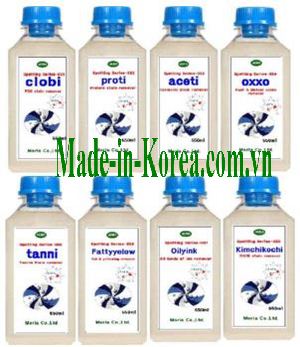Moria ‘Stain Removal’ and ‘Spotting Chemical Series’
Stain is of, in most cases, not a single component, but multicomponents, and so is not always removed in one-step, but through multi-steps sometimes. So much is the ‘Stain-Removal’ process’ scientific.
6 kinds of Stains
Stains are usually classified in ‘six categories’ as illustrated below;
1. Protein series; Egg, Milk, Meat & its Soup, Excretions, Blood, etc.Those are usually mixed with fat, sometimes with starch.
2. Tannin series; Coffee, Wine, Red tea, Soy-source, Seasoning, Catch-up, Fruit-juices, Cola, Beer, Grass, etc.
3. Starch series; All kinds of Starches.
4. Oily stain or POG, such as paint, enamel, Lacquer, Grease, Lub-oil, Tar & Pitch, Shoe wax, Crayon, Marking ink, Cosmetics, Salad oil, etc.
5. Resin series; Natural resin, Synthetic resin, Gum, Adhesives, Varnish, Manicure, etc
6. Special Stains such as Ink, Dyes, Mercurochrome and medicines containing dyes.
10 Commandments Law overcoming Stain;
1. Stains should be immediately treated, before it is gradually penetrated into fibers and/or oxidized as time passes.
2. Protain series, Tannin and Starch series of Stains can be easily removed by washing with DRYTEN-d 3 times more than normal use, as far as it is treated within one or two days.
3. If a stain is not removed with DRYTEN-d wash, please treat it with spotting of DRYTEN-d with steam-blow.
As time passes, the stain becomes harder to remove, and beat it in accordance with the following guidance;
4. Out of 6 categories of stains, Protein, Tannin, and Starch, please use ‘STAIN-OFF’, or‘DRYTEN-d’ as spotting chemical with steam-blow, and then put them into washing machine. Blood may remain yellow stain, Iron Oxide, which is well washed off by
5. oxalic acid, ‘oxxo’, ss-4, and it should be rinsed away finally with water.
Aged fatty stain resulted from urine and sweat can be well removed by ‘Fatty Yellow’, ss-6.
6. Tannin series may be first treated with ‘STAIN-OFF’ and then remaining Tannin is recommended to treat with ‘tanni’, ss-5.
7. Grease, Lub-oil, and Mineral oil, etc may be treated with ‘clobi’, ss-1.
8. Various inks, whatever it is oily or water soluble, may be treated with ‘oily-ink’, ss-7. And cosmetics with ‘aceti’, ss-3.
9. Resin-kind stains may be treated with ‘aceti’, ss-3, or ‘clobi’, ss-1.
10. Color-containing stains may be treated with ‘oily-ink’, ss7, or low temperature bleacher, ‘WHITE-L’..
10. OTHERS;
Stain-removal process must be in accordance with a sound and safe process which does not damage fiber and dye, namely, non-alkaline, @room-temperature and avoiding too strong solvent.

USES OF INDIVIDUAL SPOTTING CHEMICAL 8 SERIES;
1. clobi, ss1; is made of organic solvent and used for removing POG.
2. proti, ss2; is made of protease and used for removing protein stain.
3. aceti, ss3; is made of water soluble solvent and used for removing paint, enamel, adhesive, varnish, cosmetics and gum.
4. oxxo, ss4; is made of organic acid and used for removing iron and metal oxides.
5. tanni, ss5; is made of lactic acid and used for removing tannin.
6. Fattyyelow,ss-6; is made of enzymes and surfactant and used for removing fatty yellowing resulted from aged fatty soil
7. Oilyink ss7; is used for removing all kind of inks.
8. Kimchikochi, ss8; is used for removing chilly stain.
Spotting chemicals are made not too strong to avoid discoloration and may leave a little bit of
stain, which is further removed with bleaching powder, WHITE-L at room temterature.